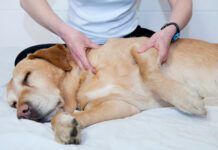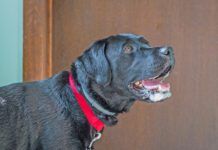In recent years, dog flu and severe canine respiratory disease of unverified etiology (causes) have resulted in many illnesses and even deaths in dogs. These two illnesses are part of a group of respiratory problems dubbed the whole canine infectious respiratory disease complex, or “CIRDC.”
Many canine respiratory illnesses are multiple pathogen problems. Often labeled “kennel cough” or “canine cough,” bacterial and viral agents interact together to cause respiratory illness. It’s when these upper respiratory infections develop further into pneumonia that we start to see cases needing hospitalization and some deaths.
Dog Flu Symptoms
Generally, symptoms of a respiratory illness in your dog are like those of the human common cold. For the milder cases, most dogs start off by coughing or sneezing. The classic “kennel cough” cough is a dry, honking sort of cough.
Some dogs may be lethargic and not have their usual appetite or zest for life. Other dogs act just fine even though they have this obnoxious cough. Dogs with chronic health conditions, senior dogs, and puppies are often the most severely affected.
Keep your dog home from day care, play dates, and training classes. Reschedule grooming appointments. All the respiratory pathogens are highly contagious.
Treating Dog Flu
Initial treatment tends to be symptomatic. You want to keep your dog quiet. The more active he is, the more he will cough, and that coughing irritates his trachea and leads to a vicious cycle of more coughing. Switching from a collar to a harness so your dog does not put pressure on his trachea from pulling while walking can also help.
With severe coughing, your veterinarian may suggest anti-cough medication to try to ease the irritation. Setting up a room with a vaporizer or keeping your dog in the bathroom while you shower can help with congestion. We may laugh about the miracle powers of chicken soup as an old wives’ tale, but if your dog will drink some down it does seem to help.
If your dog has ocular discharge or nasal discharge, you need to keep those areas clean. Use a warm compress to loosen any crusts. With any sort of purulent discharge, the likelihood of a secondary bacterial infection—therefore not a pure viral cause—becomes more likely. At that point, antibiotics may be helpful.
If your dog has difficulty breathing, or coughs so much he cannot rest comfortably, you need a veterinary visit. Dogs with pneumonia may need antibiotics, oxygen, intravenous fluids, chest coupage, and nebulization. Testing will be recommended to know exactly which pathogens your dog is dealing with.
What Is Dog Flu?
Flu is an airborne virus that fits with increased cases during winter months. This is especially true where groups of dogs might congregate such as daycare, boarding kennels, dog-sport events, groomers, dog parks, training classes, and veterinary hospitals. Any time an infected dog sneezes, coughs, or barks, they may shed the virus. To make things even trickier, dogs tend to be most likely to shed virus while incubating their infection and before they show full-blown clinical signs. Some dogs will not seem sick but can still shed the virus.
Canine influenza is associated with two flu virus strains: H3N8 and H3N2. H3N8 was first seen in 2004 in Greyhound kennels. The H3N2 variant made headlines with severe illnesses starting in the Chicago area and associated with importations of dogs from South Korea and China from 2015 through 2019. The virus caused big outbreaks with many dogs in one area infected, but it is probably endemic at this time in much of North America. To make matters worse, this is a tough virus that can survive for up to 48 hours on some surfaces, a full day on your clothing or pet bedding, and even 12 hours on your skin.
Atypical Canine Infectious Respiratory Complex (ACIRC)
In late 2022 and early 2023, a new version of canine respiratory illness, ACIRC, appeared. The first cases were in Oregon, Colorado, and New England. Many of these dogs started off with typical relatively mild respiratory signs but more than expected moved on to pneumonia. No definitive pathogen has been identified though an unusual bacterium is on the suspect list. This atypical respiratory disease is still under investigation, although outbreaks have slowed.
What Causes Dog Flu?
The list of potential pathogens for canine respiratory illnesses is a long one as identified by the American Animal Hospital Association:
Viral pathogens
- Canine adenovirus type 2
- Canine distemper virus
- Canine herpesvirus type 1
- Canine parainfluenza virus
- Canine pneumovirus
- Canine respiratory coronavirus
- H3N2 canine influenza virus
- H3N8 canine influenza virus
- Influenza A virus, to detect other
influenza strains
Bacterial pathogens
- Bordetella bronchiseptica
- Mycoplasma species
- Streptococcus zooepidemicus
It is important to remember that many dogs will have more than one culprit, such as Bordetella plus canine adenovirus. Your veterinarian will need to make the call if your dog likely has a viral problem or has some bacteria involved which would respond to antibiotics.
Can You Prevent CIRD?
Obviously, you want to avoid respiratory illness with your dog if possible. Certainly, isolation is one way, but realistically our dogs are going to get some exposure.
Start by vaccinating. The standard distemper/parvo combo usually includes adenovirus and/or parainfluenza virus. Bordetella is given separately. There are injectable, oral, and intranasal versions. Giving the intranasal version can be challenge with some dogs, but I like that it provides some local immunity. So theoretically, local immunity may attack the bacteria right as they get sniffed in. (I suspect I am well protected as well from inhaling droplets that might get flung around when I give it.)
There is a vaccine for canine influenza as well. The injectable vaccine covers both H3N8 and H3N2. Both the canine flu and Bordetella vaccines should be boostered annually.
These respiratory vaccines are considered noncore vaccines. However, if your dog goes to the dog park, groomer, training classes, boarding kennel, or daycare, you would be wise to give these vaccines. Many of these places will require proof of vaccination for these illnesses. My own dogs get these vaccines, timed to give the best boost before the winter indoor activities.





